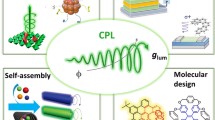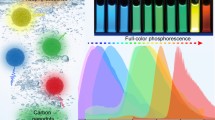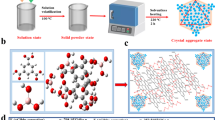Abstract
Cryo-electron microscopy has delivered a resolution revolution for biological self-assemblies, yet only a handful of structures have been solved for synthetic supramolecular materials. Particularly for chromophore supramolecular aggregates, high-resolution structures are necessary for understanding and modulating the long-range excitonic coupling. Here, we present a 3.3 Å structure of prototypical biomimetic light-harvesting nanotubes derived from an amphiphilic cyanine dye (C8S3-Cl). Helical 3D reconstruction directly visualizes the chromophore packing that controls the excitonic properties. Our structure clearly shows a brick layer arrangement, revising the previously hypothesized herringbone arrangement. Furthermore, we identify a new non-biological supramolecular motif—interlocking sulfonates—that may be responsible for the slip-stacked packing and J-aggregate nature of the light-harvesting nanotubes. This work shows how independently obtained native-state structures complement photophysical measurements and will enable accurate understanding of (excitonic) structure–function properties, informing materials design for light-harvesting chromophore aggregates.






Similar content being viewed by others
Data availability
All data required to interpret, verify and extend the results are given in the paper and its Supplementary Information. The map of both outer and inner wall LHNs is deposited in the Electron Microscopy Data Bank under accession code EMD-27820. The PDB file for inner wall structure is given in Supplementary Data 1. Source data are provided with this paper.
Code availability
Codes for the model used in the paper are available from the corresponding author upon reasonable request.
References
Bricks, J. L., Slominskii, Y. L., Panas, I. D. & Demchenko, A. P. Fluorescent J-aggregates of cyanine dyes: basic research and applications review. Methods Appl. Fluoresc. 6, 012001 (2017).
Brixner, T., Hildner, R., Köhler, J., Lambert, C. & Würthner, F. Exciton transport in molecular aggregates - from natural antennas to synthetic chromophore systems. Adv. Energy Mater. 7, 1700236 (2017).
Scholes, G. D. & Rumbles, G. Excitons in nanoscale systems. Nat. Mater. 5, 683–696 (2006).
Wang, C. & Weiss, E. A. Accelerating FRET between near-infrared emitting quantum dots using a molecular J-aggregate as an exciton bridge. Nano Lett. 17, 5666–5671 (2017).
Freyria, F. S. et al. Near-infrared quantum dot emission enhanced by stabilized self-assembled J-aggregate antennas. Nano Lett. 17, 7665–7674 (2017).
Doria, S. et al. Photochemical control of exciton superradiance in light-harvesting nanotubes. ACS Nano 12, 4556–4564 (2018).
Jelley, E. E. Spectral absorption and fluorescence of dyes in the molecular state. Nature 138, 1009–1010 (1936).
Scheibe, G. Über die Veränderlichkeit der Absorptionsspektren in Lösungen und die Nebenvalenzen als ihre Ursache. Angew. Chemie 50, 212–219 (1937).
Davydov, A. S., ydov, A. S. D., Kasha, M. & Oppenheimer, M. Theory of Molecular Excitons (McGraw-Hill, 1962).
Kasha, M. Energy transfer mechanisms and the molecular exciton model for molecular aggregates. Radiat. Res. 20, 55–71 (1963).
Czikkely, V., Försterling, H. D. & Kuhn, H. Light absorption and structure of aggregates of dye molecules. Chem. Phys. Lett. 6, 11–14 (1970).
Deshmukh, A. P. et al. Bridging the gap between H- and J-aggregates: classification and supramolecular tunability for excitonic band structures in two-dimensional molecular aggregates. Chem. Phys. Rev. 3, 021401 (2022).
Hestand, N. J. & Spano, F. C. Expanded theory of H- and J-molecular aggregates: the effects of vibronic coupling and intermolecular charge transfer. Chem. Rev. 118, 7069–7163 (2018).
Heijs, D. J., Malyshev, V. A. & Knoester, J. Decoherence of excitons in multichromophore systems: Thermal line broadening and destruction of superradiant emission. Phys. Rev. Lett. 95, 177402 (2005).
Fenna, R. E. & Matthews, B. W. Chlorophyll arrangement in a bacteriochlorophyll protein from Chlorobium limicola. Nature 258, 573–577 (1975).
Maiuri, M., Ostroumov, E. E., Saer, R. G., Blankenship, R. E. & Scholes, G. D. Coherent wavepackets in the Fenna–Matthews–Olson complex are robust to excitonic-structure perturbations caused by mutagenesis. Nat. Chem. 10, 177–183 (2018).
Panitchayangkoon, G. et al. Long-lived quantum coherence in photosynthetic complexes at physiological temperature. Proc. Natl Acad. Sci. USA. 107, 12766–12770 (2010).
Cao, J. et al. Quantum biology revisited. Sci. Adv. 6, eaaz4888 (2020).
Renger, T. Theory of excitation energy transfer: from structure to function. Photosynth. Res. 102, 471–485 (2009).
Engel, G. S. et al. Evidence for wavelike energy transfer through quantum coherence in photosynthetic systems. Nature 446, 782–786 (2007).
Eisele, D. M. et al. Robust excitons inhabit soft supramolecular nanotubes. Proc. Natl Acad. Sci. USA 111, E3367–E3375 (2014).
Lim, J. et al. Vibronic origin of long-lived coherence in an artificial molecular light harvester. Nat. Commun. 6, 7755 (2015).
Scholes, G. D., Fleming, G. R., Olaya-Castro, A. & van Grondelle, R. Lessons from nature about solar light harvesting. Nat. Chem. 3, 763–774 (2011).
Würthner, F., Kaiser, T. E. & Saha-Möller, C. R. J-aggregates: from serendipitous discovery to supramolecular engineering of functional dye materials. Angew. Chem. Int. Ed. 50, 3376–3410 (2011).
Wan, Y., Stradomska, A., Knoester, J. & Huang, L. Direct imaging of exciton transport in tubular porphyrin aggregates by ultrafast microscopy. J. Am. Chem. Soc. 139, 7287–7293 (2017).
Haedler, A. T. et al. Long-range energy transport in single supramolecular nanofibres at room temperature. Nature 523, 196–199 (2015).
Kreger, K., Schmidt, H. W. & Hildner, R. Tailoring the excited-state energy landscape in supramolecular nanostructures. Electron. Struct. 3, 023001 (2021).
Chuang, C. et al. Generalized Kasha’s model: T-dependent spectroscopy reveals short-range structures of 2D excitonic systems. Chem 5, 3135–3150 (2019).
Deshmukh, A. P. et al. Thermodynamic control over molecular aggregate assembly enables tunable excitonic properties across the visible and near-infrared. J. Phys. Chem. Lett. 11, 8026–8033 (2020).
Wasielewski, M. R. Self-assembly strategies for integrating light harvesting and charge separation in artificial photosynthetic systems. Acc. Chem. Res. 42, 1910–1921 (2009).
Pandya, R. et al. Observation of vibronic-coupling-mediated energy transfer in light-harvesting nanotubes stabilized in a solid-state matrix. J. Phys. Chem. Lett. 9, 5604–5611 (2018).
Wang, F., Gnewou, O., Solemanifar, A., Conticello, V. P. & Egelman, E. H. Cryo-EM of helical polymers. Chem. Rev. 122, 14055–14065 (2021).
Egelman, E. H. The iterative helical real space reconstruction method: Surmounting the problems posed by real polymers. J. Struct. Biol. 157, 83–94 (2007).
Herman, K. et al. Individual tubular J-aggregates stabilized and stiffened by silica encapsulation. Colloid Polym. Sci. 298, 937–950 (2020).
Ng, K. et al. Frenkel excitons in heat-stressed supramolecular nanocomposites enabled by tunable cage-like scaffolding. Nat. Chem. 12, 1157–1164 (2020).
Lafleur, R. P. M. et al. Supramolecular double helices from small C3-symmetrical molecules aggregated in water. J. Am. Chem. Soc. 142, 17644–17652 (2020).
Berlepsch, H. V., Ludwig, K., Kirstein, S. & Böttcher, C. Mixtures of achiral amphiphilic cyanine dyes form helical tubular J-aggregates. Chem. Phys. 385, 27–34 (2011).
Yi, M. et al. Enzyme responsive rigid-rod aromatics target ‘undruggable’ phosphatases to kill cancer cells in a mimetic bone microenvironment. J. Am. Chem. Soc. 144, 13055–13059 (2022).
Pawlik, A., Ouart, A., Kirstein, S., Abraham, H. W. & Daehne, S. Synthesis and UV/Vis spectra of J-aggregating 5,5′,6,6′-tetrachlorobenzimidacarbocyanine dyes for artificial light-harvesting systems and for asymmetrical generation of supramolecular helices. Eur. J. Org. Chem. 2003, 3065–3080 (2003).
Caram, J. R. et al. Room-temperature micron-scale exciton migration in a stabilized emissive molecular aggregate. Nano Lett. 16, 6808–6815 (2016).
Eisele, D. M., Knoester, J., Kirstein, S., Rabe, J. P. & Vanden Bout, D. A. Uniform exciton fluorescence from individual molecular nanotubes immobilized on solid substrates. Nat. Nanotechnol. 4, 658–663 (2009).
Clark, K. A., Cone, C. W. & Vanden Bout, D. A. Quantifying the polarization of exciton transitions in double-walled nanotubular J-aggregates. J. Phys. Chem. C 117, 26473–26481 (2013).
Eisele, D. M. et al. Utilizing redox-chemistry to elucidate the nature of exciton transitions in supramolecular dye nanotubes. Nat. Chem. 4, 655–662 (2012).
Kirstein, S. et al. Chiral J-aggregates formed by achiral cyanine dyes. ChemPhysChem 1, 146–150 (2000).
Schade, B. et al. Stereochemistry-controlled supramolecular architectures of new tetrahydroxy-functionalised amphiphilic carbocyanine dyes. Chem. Eur. J. 26, 6919–6934 (2020).
Roodenko, K. et al. Anisotropic optical properties of thin-film thiacarbocyanine dye aggregates. J. Phys. Chem. C 117, 20186–20192 (2013).
Kriete, B., Feenstra, C. J. & Pshenichnikov, M. S. Microfluidic out-of-equilibrium control of molecular nanotubes. Phys. Chem. Chem. Phys. 22, 10179–10188 (2020).
Bialas, D., Zhong, C., Würthner, F. & Spano, F. C. Essential states model for merocyanine dye stacks: bridging electronic and optical absorption properties. J. Phys. Chem. C 123, 18654–18664 (2019).
Spano, F. C. Analysis of the UV/Vis and CD spectral line shapes of carotenoid assemblies: spectral signatures of chiral H-aggregates. J. Am. Chem. Soc. 131, 4267–4278 (2009).
Patmanidis, I. et al. Structural characterization of supramolecular hollow nanotubes with atomistic simulations and SAXS. Phys. Chem. Chem. Phys. 22, 21083–21093 (2020).
Egelman, E. H. Reconstruction of helical filaments and tubes. Methods Enzymol. 482, 167–183 (2010).
Egelman, E. H. Ambiguities in helical reconstruction. eLife 3, e04969 (2014).
Pieri, L. et al. Atomic structure of Lanreotide nanotubes revealed by cryo-EM. Proc. Natl Acad. Sci. USA 119, e2120346119 (2022).
Megow, J. et al. Site-dependence of van der Waals interaction explains exciton spectra of double-walled tubular J-aggregates. Phys. Chem. Chem. Phys. 17, 6741–6747 (2015).
Bondarenko, A. S. et al. Multiscale modeling of molecular structure and optical properties of complex supramolecular aggregates. Chem. Sci. 11, 11514–11524 (2020).
Herbst, S. et al. Self-assembly of multi-stranded perylene dye J-aggregates in columnar liquid-crystalline phases. Nat. Commun. 9, 2646 (2018).
Didraga, C. et al. Structure, spectroscopy, and microscopic model of tubular carbocyanine dye aggregates. J. Phys. Chem. B 108, 14976–14985 (2004).
Clark, K. A., Krueger, E. L. & Vanden Bout, D. A. Direct measurement of energy migration in supramolecular carbocyanine dye nanotubes. J. Phys. Chem. Lett. 5, 2274–2282 (2014).
Doria, S. et al. Vibronic coherences in light harvesting nanotubes: unravelling the role of dark states. J. Mater. Chem. C 10, 7216–7226 (2022).
Spano, F. C., Silvestri, L., Spearman, P., Raimondo, L. & Tavazzi, S. Reclassifying exciton-phonon coupling in molecular aggregates: evidence of strong nonadiabatic coupling in oligothiophene crystals. J. Chem. Phys. 127, 184703 (2007).
Krueger, B. P., Scholes, G. D. & Fleming, G. R. Calculation of couplings and energy-transfer pathways between the pigments of LH2 by the ab initio transition density cube method. J. Phys. Chem. B 102, 5378–5386 (1998).
Didraga, C., Klugkist, J. A. & Knoester, J. Optical properties of helical cylindrical molecular aggregates: the homogeneous limit. J. Phys. Chem. B 106, 11474–11486 (2002).
Bondarenko, A. S., Jansen, T. L. C. & Knoester, J. Exciton localization in tubular molecular aggregates: Size effects and optical response. J. Chem. Phys. 152, 194302 (2020).
Bloemsma, E. A., Vlaming, S. M., Malyshev, V. A. & Knoester, J. Signature of anomalous exciton localization in the optical response of self-assembled organic nanotubes. Phys. Rev. Lett. 114, 156804 (2015).
Kriete, B. et al. Steering self-assembly of amphiphilic molecular nanostructures via halogen exchange. J. Phys. Chem. Lett. 8, 2895–2901 (2017).
Wang, F. et al. Spindle-shaped archaeal viruses evolved from rod-shaped ancestors to package a larger genome. Cell 185, 1297–1307.e11 (2022).
Desiraju, G. R. Crystal engineering: from molecule to crystal. J. Am. Chem. Soc. 135, 9952–9967 (2013).
Bailey, A. D. et al. Exploring the design of superradiant J-aggregates from amphiphilic monomer units. Nanoscale 15, 3841–3849 (2023).
Lotya, M., Rakovich, A., Donegan, J. F. & Coleman, J. N. Measuring the lateral size of liquid-exfoliated nanosheets with dynamic light scattering. Nanotechnology 24, 265703 (2013).
Zivanov, J. et al. New tools for automated high-resolution cryo-EM structure determination in RELION-3. eLife 7, e42166 (2018).
Goddard, T. D., Huang, C. C. & Ferrin, T. E. Visualizing density maps with UCSF Chimera. J. Struct. Biol. 157, 281–287 (2007).
Emsley, P., Lohkamp, B., Scott, W. G. & Cowtan, K. Features and development of Coot. Acta Crystallogr. Sect. D 66, 486–501 (2010).
Adams, P. D. et al. PHENIX: A comprehensive Python-based system for macromolecular structure solution. Acta Crystallogr. D Biol. Crystallogr. 66, 213–221 (2010).
von Berlepsch, H., Kirstein, S., Hania, R., Pugžlys, A. & Böttcher, C. Modification of the nanoscale structure of the J-aggregate of a sulfonate-substituted amphiphilic carbocyanine dye through incorporation of surface-active additives. J. Phys. Chem. B 111, 1701–1711 (2007).
Lyon, J. L. et al. Spectroelectrochemical investigation of double-walled tubular J-aggregates of amphiphilic cyanine dyes. J. Phys. Chem. C 112, 1260–1268 (2008).
Krishnaswamy, S. R. et al. Cryogenic TEM imaging of artificial light harvesting complexes outside equilibrium. Sci. Rep. 12, 5552 (2022).
Patmanidis, I. et al. Modelling structural properties of cyanine dye nanotubes at coarse-grained level. Nanoscale Adv. 4, 3033–3042 (2022).
Manrho, M. et al. Watching molecular nanotubes self-assemble in real time. J. Am. Chem. Soc. 145, 22494–22503 (2023).
Acknowledgements
This work was funded by National Science Foundation Division of Chemistry grant 2204263 (E.M.S. and J.R.C.) and National Institutes of Health grant GM122510 (E.H.E.). A.P.D. thanks the University of California, Los Angeles Graduate Division Dissertation Year Fellowship for financial support. The authors acknowledge the use of the University of California, Los Angeles-Department of Energy Biochemistry Instrumentation Core Facility and University of California, Los Angeles Molecular Instrumentation Center. C.C. acknowledges start-up funding from University of Nevada, Las Vegas.
Author information
Authors and Affiliations
Contributions
A.P.D. was responsible for preparing the first draft, editing, conceptualization, LHNs spectroscopy and sample preparation. W.Z. was responsible for cryo-EM imaging and reconstruction and editing. C.C. was responsible for dimerized Frenkel exciton model, outer wall model, writing and editing. A.D.B. was responsible for synthesis of chemically modified dyes, isolated inner wall sample prep and spectroscopy and editing. J.A.W. was responsible for aggregate screening and cryo-EM imaging of C8S4-Cl and C8S3-Br and editing. E.M.S. was responsible for advising and editing. E.H.E. was responsible for advising, editing and conceptualization. J.R.C. was responsible for advising, editing and conceptualization.
Corresponding author
Ethics declarations
Competing interests
The authors declare no competing interests.
Peer review
Peer review information
Nature Chemistry thanks Thomas Jansen, Maxim Pshenichnikov and the other, anonymous, reviewer(s) for their contribution to the peer review of this work.
Additional information
Publisher’s note Springer Nature remains neutral with regard to jurisdictional claims in published maps and institutional affiliations.
Extended data
Extended Data Fig. 1 Structure of inner wall asymmetric unit.
Left: Inner wall asymmetric unit (hydrogen atoms are omitted for clarity) obtained from the refined inner wall model, right: the corresponding ChemDraw structure.
Extended Data Fig. 2 Circular dichroism spectra of identical LHN samples.
Circular dichroism spectra of four identical LHN samples in 30% MeOH:H2O mixtures and 0.43 mM final dye concentration.
Extended Data Fig. 3 Zoomed-in inner wall density.
Cut away top-down view of the inner wall. The sulfonate lobes (denoted by black arrows) show a regular interlocked pattern.
Extended Data Fig. 4 Outer wall molecular model.
Outer wall density overlayed with the fitted molecular model with manual constraints. a. side view, b. cut-away view, and c. asymmetric unit (ASU). The sulfonate interlocking can be seen in the outer wall as well.
Extended Data Fig. 5 Calculated spectra from the dimerized Frenkel exciton model.
a. Absorption, b. linear dichroism, and c. circular dichroism spectra of isolated inner walls of the LHNs. Solid black lines: experimental spectra; colored lines: spectra calculated from the dimerized Frenkel exciton Hamiltonian corresponding to inner wall structures of varying sizes, blue: 1500, red: 3000, yellow: 4500, and purple: 6000 monomers; dashed black lines: calculated spectra assuming periodic boundary conditions with added Lorentizian broadenings. The lineshape of the perpendicular peaks depends more strongly on the tube length truncation than their parallel counterparts which could possibly introduce more lineshape mismatch for the perpendicular peaks.
Extended Data Fig. 6 C8S3-Br nanotubes self-assembly over long time.
a Dynamic light scattering (DLS) intensity distributions of C8S3-Br nanotubes in solutions (20% MeOH v/v in MeOH:H2O mixture with 0.2 mM dye concentration) at various time intervals after aggregate preparation. The distribution depicts shorter lengths initially at 10 min and then shifts to drastically longer lengths over a course of 5 weeks. We note that the DLS scattering intensities are related to the hydrodynamic diameters of the freely diffusing nanotubes and can be used to estimate the length of the nanotubes, b. normalized absorption spectra corresponding to each time point showing a slow conversion from nanotubes to bundles, c. and d. representative cryo-EM images of the samples frozen 1 day and 5 weeks after aggregate preparation, respectively.
Extended Data Fig. 7 C8S4-Cl aggregate absorption spectra over a week.
a. Absorption spectra of C8S4-Cl aggregates made at 0.1 mM dye concentration and 5% MeOH over a course of 7 days showing conversion to sheet-like morphology, and b. normalized absorption spectra of the monomer in 100% MeOH (black), sheets in 20% MeOH (blue) and tubes in 5% MeOH (red) with 0.1 mM final dye concentration.
Supplementary information
Supplementary Information
Dimerized Frenkel exciton model, geometric model for C8S3-Br, synthesis details for C8S4-Cl and table of cryo-EM data collection.
Supplementary Data 1
Co-ordinates file for the inner wall structure.
Source data
Source Data Fig. 1
Absorption spectra of C8S3-Cl monomer and LHNs; linear dichroism spectra of the isolated inner walls.
Source Data Fig. 4
Calculated and experimental spectra for the isolated inner wall.
Source Data Fig. 5
C8S3-Cl and C8S3-Br aggregate absorptions, tube widths, FFT C8S3-Br tube widths, C8S3-Cl and C8S4-Cl aggregate absorptions.
Source Data Extended Data Fig. 2
Circular dichroism spectra of the LHNs.
Source Data Extended Data Fig. 5
Calculated and experimental spectra for the isolated inner wall with different sizes of the tubes.
Source Data Extended Data Fig. 6
DLS and aggregate absorption spectra over time for C8S3-Br.
Source Data Extended Data Fig. 7
Absorption spectra of C8S4-Cl over time, normalized spectra of C8S4-Cl sheets, tubes and monomers.
Rights and permissions
Springer Nature or its licensor (e.g. a society or other partner) holds exclusive rights to this article under a publishing agreement with the author(s) or other rightsholder(s); author self-archiving of the accepted manuscript version of this article is solely governed by the terms of such publishing agreement and applicable law.
About this article
Cite this article
Deshmukh, A.P., Zheng, W., Chuang, C. et al. Near-atomic-resolution structure of J-aggregated helical light-harvesting nanotubes. Nat. Chem. (2024). https://doi.org/10.1038/s41557-023-01432-6
Received:
Accepted:
Published:
DOI: https://doi.org/10.1038/s41557-023-01432-6
- Springer Nature Limited





